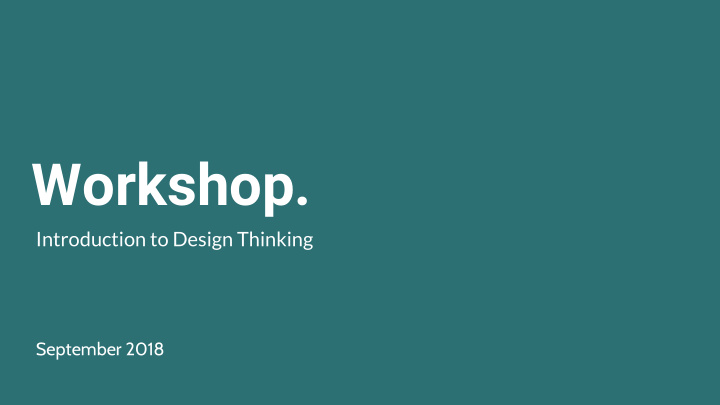



Workshop. Introduction to Design Thinking September 2018
Workshop is a design-thinking practice with a It’s nice mission-bent. We help purpose-driven teams design new products and services. We work with innovators to meet in health and sustainability. Workshop takes a human-centered, insight-driven you. approach to innovation. We use agile methodology to move an idea quickly through the process of research > strategy > roadmap. We work around the world, but we are based at American Underground in downtown Durham.
+ Introduction to Design Thinking Here’s + Problem statement + Human-centered + Agile iteration what to + Break-Out Exercise in Teams + Problem Statement Worksheet expect. + Research Planning Worksheet + Reconvene + Next Time
Design Thinking Principles + Tools
“A problem well-stated is a problem half-solved.” - Charles Kettering Understand + Hold off from jumping to solutions right away + Let the problem be your inspiration the problem + How might we…? you’re trying + Explore your user’s perspective + What problem are they experiencing? to solve. + Learn from their current workarounds + Focus your work, contain your scope + What are we going to tackle? + What are we not going to tackle? + Tools to use: + Problem Statement worksheet + User research
+ Design with empathy + Design for end-users (not yourself or your clients) Put people at + Product success = solving a problem for the user the center + Challenge your assumptions + F.O.G. ? (Is it a fact, opinion or guess?) your process. + Test and validate your assumptions with users + Design along with users + Early research to inform requirements + Check in regularly and test prototypes with users + Tools to use: + User research (at the beginning) + Personas + Journey maps (experience in and around the application) + User testing (during prototyping, design and development)
+ Design > Test > Learn > Refine + Assume you won’t get it right the first time (or even the Design and second time) + “You don’t know what you don’t know.” build in an + Progress from low-fidelity to high-fidelity iterative way. + Concept note > paper sketch > wireframe > clickable prototype + Feedback loops with users + Test your prototypes and refine based on feedback + Observe how they interact with your application + Tools to use: + Pen-and-paper! + Rapid prototyping + User testing + UX applications for prototyping (e.g., Sketch, InVision)
Design thinking Case study
Our assignment (and our assumptions.) + Children in Tanzania aren’t getting the immunizations they need. + Immunization Managers in Tanzania need training on how to store, dispense and track immunizations in their district. + Training is currently human-intensive, costly, inconsistent and not repeatable. + We need to build a video-based learning platform to provide consistent, accessible training to immunization managers on-demand, no matter where they are in Tanzania. Assumption alert! So, we went to Tanzania, and what did we discover?
Breakouts
Your assignment today 1. Problem Statement worksheet (15 minutes) 2. Research Plan worksheet (15 minutes) 3. Reconvene to share and ask questions (15 minutes)
Your assignment for 9/19 1. Updated problem statement worksheet (ready to share) 2. User research complete (ready to share) IDEO offers many excellent (and free!) resources on + One-page summary of key themes and findings Design Thinking. + How is your user research informing your solution? + What assumptions did you have before user research? For user research, check out this guide on interviews.
Thank you!
Meaningful innovation in a faster, smarter way. www.weareworkshop.io +1.919.537.5223 hello@weareworkshop.io American Underground Suite 205 212 West Main Street Durham, NC 27701 USA
Recommend
More recommend